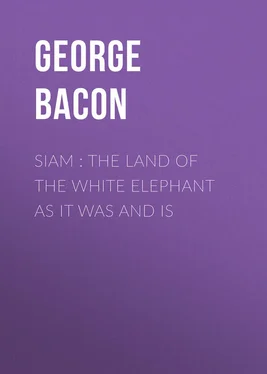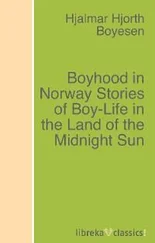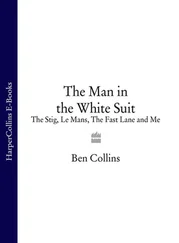George Bacon - Siam - The Land of the White Elephant as It Was and Is
Здесь есть возможность читать онлайн «George Bacon - Siam - The Land of the White Elephant as It Was and Is» — ознакомительный отрывок электронной книги совершенно бесплатно, а после прочтения отрывка купить полную версию. В некоторых случаях можно слушать аудио, скачать через торрент в формате fb2 и присутствует краткое содержание. ISBN: , Жанр: foreign_antique, foreign_prose, Путешествия и география, на английском языке. Описание произведения, (предисловие) а так же отзывы посетителей доступны на портале библиотеки ЛибКат.
- Название:Siam : The Land of the White Elephant as It Was and Is
- Автор:
- Жанр:
- Год:неизвестен
- ISBN:http://www.gutenberg.org/ebooks/38078
- Рейтинг книги:3 / 5. Голосов: 1
-
Избранное:Добавить в избранное
- Отзывы:
-
Ваша оценка:
- 60
- 1
- 2
- 3
- 4
- 5
Siam : The Land of the White Elephant as It Was and Is: краткое содержание, описание и аннотация
Предлагаем к чтению аннотацию, описание, краткое содержание или предисловие (зависит от того, что написал сам автор книги «Siam : The Land of the White Elephant as It Was and Is»). Если вы не нашли необходимую информацию о книге — напишите в комментариях, мы постараемся отыскать её.
Siam : The Land of the White Elephant as It Was and Is — читать онлайн ознакомительный отрывок
Ниже представлен текст книги, разбитый по страницам. Система сохранения места последней прочитанной страницы, позволяет с удобством читать онлайн бесплатно книгу «Siam : The Land of the White Elephant as It Was and Is», без необходимости каждый раз заново искать на чём Вы остановились. Поставьте закладку, и сможете в любой момент перейти на страницу, на которой закончили чтение.
Интервал:
Закладка:
A third river system, that of the Mekong, much the largest of all the rivers in Indo-China, drains the extreme north and east of Siam. This huge stream, which is also mentioned in Camoens' Lusiad, takes its rise near the sources of the Yangtse Kiang in Eastern Thibet, and belongs in nearly half its course to China. It was partly explored by M. Mouhot, and later (in 1868) by Lagrée's expedition, who found it, in spite of the great body of water, impracticable for navigation. M. de Carné, one of the exploration party, thus sums up the results of the search for a new trade route into Southern China: "The difficulties the river offers begin at first, starting from the Cambodian frontier, and they are very serious, if not insurmountable. If it were attempted to use steam on this part of the Mekong the return would be most dangerous. At Khong an absolutely impassable barrier, as things are, stands in the way. Between Khong and Bassac the waters are unbroken and deep, but the channel is again obstructed a short distance from the latter. From the mouth of the river Ubone the Mekong is nothing more than an impetuous torrent, whose waters rush along a channel more than a hundred yards deep by hardly sixty across. Steamers can never plough the Mekong as they do the Amazon or the Mississippi, and Saigon can never be united to the western provinces of China by this immense waterway, whose waters make it mighty indeed, but which seems after all to be a work unfinished."
Of the tributary states, the Laos, who occupy the Mekong valley and spread themselves among the wilds between Tongking, China, and Siam, are probably the least known. In physique and speech they are akin to the Siamese, and are regarded by some writers as being the primitive stock of that race. They have some claims as a people of historical importance, constituting an ancient and powerful kingdom whose capital Vein-shan, was destroyed by Siam in 1828. Since then they have remained subject to Siam, being governed partly by native hereditary princes, duly invested with gold dish, betel-box, spittoon, and teapot sent from Bangkok, and partly by officers appointed by the Siamese government. Their besetting sin is slave-hunting, which was until recently pursued with the acquiescence of the Siam authorities, to the terror of the hill-tribes within their reach and to their own demoralization. Apart from the passions associated with this infamous trade the Laos are for the most part an inoffensive, unwarlike race, fond of music, and living chiefly on a diet of rice, vegetables, fruits, fish, and poultry. Pure and mixed, they number altogether perhaps some one million five hundred thousand.
The most important of the Malay states is Quedha, in Siamese Muang Sai. Its population of half a million Malays is increased by some twenty thousand Chinese and perhaps five thousand of other races. The country is level land covered with fine forests, where elephants, tigers, and rhinoceroses abound. A high range of mountains separates Quedha from the provinces of Patani (noted for its production of rice and tin) and Songkhla. These again are divided from the province of Kalantan by the Banara River, and from Tringann by the Batut River. In Ligor province, called in Siamese Lakhon, three-fourths of the population are Siamese. The gold and silver-smiths of Ligor have a considerable reputation for their vessels of the precious metals inlaid with a black enamel.
As to the Cambodian provinces under Siamese rule the following particulars are extracted from a paper by M. Victor Berthier:
The most important provinces are those lying to the west, Battambang and Korat. The former of these is situated on the west of the Grand Lake (Tonle Sap), and supports a population of about seventy thousand, producing salt, fish, rice, wax, and cardamoms, besides animals found in the forests. Two days' march from Battambang is the village of Angkor Borey (the royal town), the great centre of the beeswax industry, of which 24,000 pounds are sent yearly to Siam. Thirty miles from this place is situated the auriferous country of Tu'k Cho, where two Chinese companies have bought the monopoly of the mines. The metal is obtained by washing the sand extracted from wells about twenty feet deep, at which depth auriferous quartz is usually met, but working as they do the miners have no means of getting ore from the hard stone.
Korat is the largest province and is peopled almost entirely by Cambodians. Besides its chief town of the same name it contains a great number of villages with more than eleven district centres, and contains a population estimated at fifty thousand or sixty thousand. Angkor, the most noted of the Cambodian provinces, is now of little importance, being thinly populated and chiefly renowned for the splendor of its ancient capital, whose remarkable ruins are the silent witnesses of a glorious past. The present capital is Siem Rap, a few miles south of which is the hill called Phnom Krom (Inferior Mount), which becomes an island during the annual inundation. The other Cambodian provinces now ruled by Siam are almost totally unknown by Europeans.
The population of Siam has never been officially counted, but is approximately estimated by Europeans at from six to twelve millions. According to Mr. Archibald Colquhoun, however, this is based upon an entirely erroneous calculation. "Prince Prisdang assured me," he says, 1 1 Amongst the Shans. London, 1885.
"that Sir John Bowring had made a great mistake in taking the list of those who were liable to be called out for military service as the gross population of the kingdom; and that if that list were multiplied by five, it would give a nearer approximation to the population. M. Mouhot says that a few years before 1862 the native registers showed for the male sex (those who were inscribed), 2,000,000 Siamese, 1,000,000 Laotians (or Shans), 1,000,000 Malays, 1,500,00 °Chinese, 350,00 °Cambodians, 50,000 Peguans, and a like number composed of various tribes inhabiting the mountain-ranges. Taking these statistics and multiplying them by five, which Bishop Pallegoix allows is a fair way of computing from them, we should have a population of 29,950,000. To this would have to be added the Chinese and Peguans who had not been born in the country, and were therefore not among the inscribed; also the hill tribes that were merely tributary and therefore merely paid by the village, as well as about one-seventh of the above total for the ruling classes, their families and slaves. This total would give at least 35,000,000 inhabitants for Siam Proper, to which would have to be added about 3,000,000 for its dependencies, Zimmé (Cheung Mai), Luang Prabang, and Kiang Tsen, – a gross population, therefore, of about 38,000,000 for the year 1860." On the other hand, Mr. McCarthy, a competent judge, considers the government estimate of ten million too high.
CHAPTER III.
OLD SIAM – ITS HISTORY
The date at which any coherent and trustworthy history of Siam must commence is the founding of the sacred city of Ayuthia (the former capital of the kingdom), in the year 1350 of the Christian era. Tradition, more or less obscure and fabulous, does indeed reach back into the remote past so far as the fifth century, B.C. According to the carefully arranged chronology of Bishop Pallegoix, gathered from the Siamese annals, which annals, however, are declared by His Majesty the late King to be "all full of fable, and are not in satisfaction for believe," the origin of the nation can be traced back, if not into indefinite space of time, at least into the vague and uncertain "woods," and ran on this wise:
"There were two Brahminical recluses dwelling in the woods, named Sătxănalăi and Sîtthĭongkŏn, coeval with Plua Khôdŏm (the Buddha), and one hundred and fifty years of age, who having called their numerous posterity together, counselled them to build a city having seven walls, and then departed to the woods to pass their lives as hermits.
Читать дальшеИнтервал:
Закладка:
Похожие книги на «Siam : The Land of the White Elephant as It Was and Is»
Представляем Вашему вниманию похожие книги на «Siam : The Land of the White Elephant as It Was and Is» списком для выбора. Мы отобрали схожую по названию и смыслу литературу в надежде предоставить читателям больше вариантов отыскать новые, интересные, ещё непрочитанные произведения.
Обсуждение, отзывы о книге «Siam : The Land of the White Elephant as It Was and Is» и просто собственные мнения читателей. Оставьте ваши комментарии, напишите, что Вы думаете о произведении, его смысле или главных героях. Укажите что конкретно понравилось, а что нет, и почему Вы так считаете.












